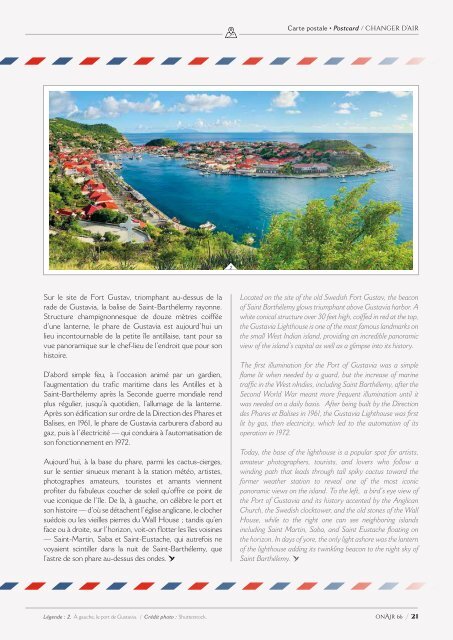ON AIR MAGAZINE #66
Create successful ePaper yourself
Turn your PDF publications into a flip-book with our unique Google optimized e-Paper software.
Carte postale • Postcard / Changer d’air<br />
2<br />
Sur le site de Fort Gustav, triomphant au-dessus de la<br />
rade de Gustavia, la balise de Saint-Barthélemy rayonne.<br />
Structure champignonnesque de douze mètres coiffée<br />
d’une lanterne, le phare de Gustavia est aujourd’hui un<br />
lieu incontournable de la petite île antillaise, tant pour sa<br />
vue panoramique sur le chef-lieu de l’endroit que pour son<br />
histoire.<br />
D’abord simple feu, à l’occasion animé par un gardien,<br />
l’augmentation du trafic maritime dans les Antilles et à<br />
Saint-Barthélemy après la Seconde guerre mondiale rend<br />
plus régulier, jusqu’à quotidien, l’allumage de la lanterne.<br />
Après son édification sur ordre de la Direction des Phares et<br />
Balises, en 1961, le phare de Gustavia carburera d’abord au<br />
gaz, puis à l’électricité — qui conduira à l’automatisation de<br />
son fonctionnement en 1972.<br />
Aujourd’hui, à la base du phare, parmi les cactus-cierges,<br />
sur le sentier sinueux menant à la station météo, artistes,<br />
photographes amateurs, touristes et amants viennent<br />
profiter du fabuleux coucher de soleil qu’offre ce point de<br />
vue iconique de l’île. De là, à gauche, on célèbre le port et<br />
son histoire — d’où se détachent l’église anglicane, le clocher<br />
suédois ou les vieilles pierres du Wall House ; tandis qu’en<br />
face ou à droite, sur l’horizon, voit-on flotter les îles voisines<br />
— Saint-Martin, Saba et Saint-Eustache, qui autrefois ne<br />
voyaient scintiller dans la nuit de Saint-Barthélemy, que<br />
l’astre de son phare au-dessus des ondes.<br />
Located on the site of the old Swedish Fort Gustav, the beacon<br />
of Saint Barthélemy glows triumphant above Gustavia harbor. A<br />
white conical structure over 30 feet high, coiffed in red at the top,<br />
the Gustavia Lighthouse is one of the most famous landmarks on<br />
the small West Indian island, providing an incredible panoramic<br />
view of the island’s capital as well as a glimpse into its history.<br />
The first illumination for the Port of Gustavia was a simple<br />
flame lit when needed by a guard, but the increase of marine<br />
traffic in the West nIndies, including Saint Barthélemy, after the<br />
Second World War meant more frequent illumination until it<br />
was needed on a daily basis. After being built by the Direction<br />
des Phares et Balises in 1961, the Gustavia Lighthouse was first<br />
lit by gas, then electricity, which led to the automation of its<br />
operation in 1972.<br />
Today, the base of the lighthouse is a popular spot for artists,<br />
amateur photographers, tourists, and lovers who follow a<br />
winding path that leads through tall spiky cactus toward the<br />
former weather station to reveal one of the most iconic<br />
panoramic views on the island. To the left, a bird’s eye view of<br />
the Port of Gustavia and its history accented by the Anglican<br />
Church, the Swedish clocktower, and the old stones of the Wall<br />
House, while to the right one can see neighboring islands<br />
including Saint Martin, Saba, and Saint Eustache floating on<br />
the horizon. In days of yore, the only light ashore was the lantern<br />
of the lighthouse adding its twinkling beacon to the night sky of<br />
Saint Barthélemy.<br />
Légende : 2. À gauche, le port de Gustavia. / Crédit photo : Shutterstock.<br />
onAir 66<br />
21

















